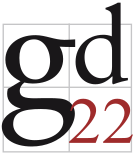GD2022 PhD School
Program
| Event (JST) | Speaker |
|---|---|
| Sep. 12, 01:00PM - 03:00PM | Yoshio Okamoto |
| Sep. 12, 03:00PM - 05:00PM | Shigeo Takahashi / Hsiang-Yun Wu |
| Sep. 13 09:30AM - 11:30AM | Amyra Meidiana |
| Sep. 13 01:00PM - 03:00PM | Tony Huang |
| Sep. 13 03:00PM - 05:00PM | Martin Nöllenburg |
| 90 minutes talk and 30 minites Q&A/break |
Lecturers
Yoshio Okamoto (The University of Electro-Communications, Japan)
Title:
Angular Resolution in Graph Drawing
Abstract:
Angular resolution is one of the well-known aesthetic criteria for graph drawing, but its theoretical properties are not well understood. For a straight-line drawing of a graph, its vertex angular resolution is the minimum angle formed by two consecutive edges around a vertex, and its crossing angular resolution is the minimum angle formed by a crossing, while the crossing angular resolution is defined to be 360 degrees if there is no crossing. The total angular resolution of a straight-line drawing is the minimum of the vertex angular resolution and the crossing angular resolution. The vertex/crossing/total angular resolution of a graph is the supremum of the vertex/crossing/total angular resolution of any straight-line drawing of the graph. In this talk, we review some of the results on angular resolution in the literature, and identify several open problems in the field.
Shigeo Takahashi (University of Aizu, Japan), Hsiang-Yun Wu (St. Pölten University of Applied Sciences, Austria)
Title:
Real-world examples toward visual diagram placement problems
Abstract:
This tutorial presents case studies on how real-world examples yield practical hints for improving visual diagram representations.
We will first introduce the concept of schematization, which has been commonly incorporated in transit maps and other complex diagrams. Using different schematization strategies allows us to illuminate low-level details about the underlying complex networks while distinguishing the high-level structures. We solved this problem by introducing map metaphors that arrange the schematized layout in order to manage network visual complexity hierarchically. We show an overview of common design criteria and use cases, and specifically, our ideas used to visually untangle complicated pathways inherent in biological systems.
We then present another case study for animating the visual explanation of dynamic set diagrams. We conducted this animation design by solving problems for optimizing railway schedules. More specifically, we first decomposed the dynamic set diagram into atomic changes and then mapped each change to a fundamental component that constitutes the entire railway schedule. We demonstrate how such railway scheduling algorithms successfully inspired us to improve the visual readability in the animation of dynamic set diagrams.
Amyra Meidiana (The University of Sydney, Australia)
Title:
Visualisation of Big Complex Graphs
Abstract:
With the continuing ability to gather and store increasingly larger amounts of data, so has grown the size of network data. However, traditional force-directed algorithms, running in quadratic-time, do not scale efficiently when visualising these big, complex graphs. In the first part of the talk, we will discuss algorithms for efficient visualisation of large and complex graphs, from near-linear-time algorithms to sublinear-time algorithms. Quality metrics are important for evaluation of graph drawing algorithms, however traditional readability metrics have been shown less effective in evaluating drawings of big complex graphs. The second part of the talk will focus on the faithfulness metrics, which are specifically designed for evaluating drawings of large complex graphs and measure how faithfully the drawings displays the ground truth information of the underlying graphs.
Tony Huang (University of Technology Sydney, Australia)
Title:
Evaluation methodologies and practices in information visualisation
Abstract:
Evaluation plays an important role in the design process of effective visualisations. In this talk, we will present general evaluation methodologies, summarise the typical evaluation practices in the information visualisation research and demonstrate how evaluation can help us to test hypotheses and derive new insights from evaluation results. The main take-away messages from this talk will be the understanding of the importance of evaluation and good evaluation practices for different research purposes.
Martin Nöllenburg (Technische Universitat Wien, Austria)
Title:
Crossing layout for non-planar graph drawing
Abstract:
Edge crossings are typically undesired in graph drawings as they negatively affect readability. Yet non-planar graphs are abundant in applications and hence we need techniques for better graph layouts in the presence of some edge crossings. We discuss different approaches to improve the geometric representation of crossings and take a look at their corresponding algorithmic problems.

